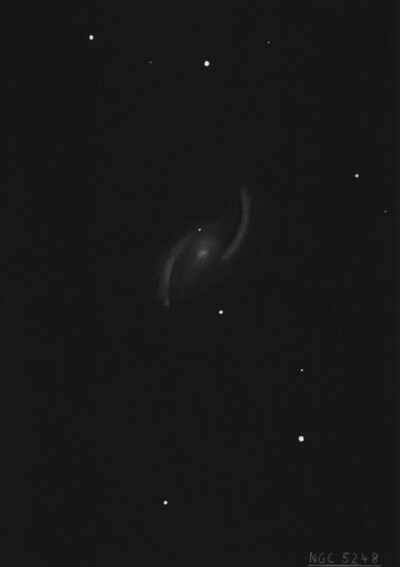
William Herschel discovered NGC 5248 = H I-34 = h1650 on 15 Apr 1784 (sweep 194) and recorded "vB, nearly R and cometic but the nucleus is large and seems to consist of bright close stars, resolvable." On 1 May 1786 (sweep 560) he logged "vB, cL, E from np to sf, a small bright nucleus."
R.J. Mitchell, observing on 19 Apr 1855 with LdR's 72", logged "Large and pretty bright, Bright nucleus. Seen as in sketch, but not certain whether the lower branch joins the nucleus or is only the continuation of the upper curve." On 29 March 1856 he recorded "The preceding arm does appear to originate from the nucleus, which is very bright and oval shaped." The two brightest spiral arms as well as the brightest HII knot at the southeast end of the eastern arm, are clearly shown on Plate XXVIII, fig 29 in PT 1861
400/500mm - 17.5" (5/30/92): bright, large, slightly elongated WNW-ESE, 4'x3', well-defined small very bright core, almost stellar nucleus. A mag 13 star lies 1.7' SSW of center and a mag 15 star is embedded at the north edge of the halo. Appears slightly mottled or dusty but spiral arms were not seen.
600/800mm - 24" (5/24/20): at 225x, 260x and 375x; beautiful two-armed spiral elongated NW-SE, sharply concentrated with a very bright oval core that appeared mottled and a small brighter nucleus. A fairly well defined spiral arm was attached on the NE side, near an easy mag 15.3 star 0.7' N of center. It curved clockwise along the east side and appeared somewhat diffuse, blending into the glow of the disc on the interior and exterior sides. It terminated at a very diffuse HII patch ([HK 83] #9), 1.2' SE of center.
The western arm had a higher surface brightness with a very sharply defined outer edge and a mottled or uneven appearance. It was easily traced at 225x and 375x with the brightest part detached from the core and extended almost due north, terminating 1.5' NW of center. Both arms were immersed in the haze of the disc ~3.5'x2.5'. A mag 13.7 star is 1.7' S, just outside the halo.
900/1200mm - 48" (5/15/12): beautiful two-armed spiral, very large, elongated ~3:2 SW-NE. The brightest portion is ~3.8'x2.5' but the faint, outer spiral arms increase the diameter to at least 5'. The galaxy is sharply concentrated with an intense oval core. The brighter spiral arm begins to the north of the core, wrapping counterclockwise around the east and southeast side and it is lit up by several fairly prominent knots. The arm dims fairly abruptly on the southeast side but continues unwrapping to the south, extending outside and just beyond a mag 13.5-14 star 1.7' SSW of center. A mag 15.3 star is 0.6' N of center, just outside where the arm emerges on the north side.
At least four distinct HII knots are in or near this arm, along with brighter segments. The following designations are from the 1983 Hodge-Kennicutt "An Atlas of H II regions in 125 galaxies". A faint knot, [HK 83] 26/28 is between the mag 15.3 star and the core. The arm brightens along the east side of the core and include the faint knots [HK 83] 13/15, 28" NE of center, and [HK 83] 5/6 1.0' ESE of center. The most prominent knot along with this arm is [HK 83] 9, 1.2' SE of center.
The western spiral arm (not traced directly to the core) stretches to the north and also contains several knots (HII complexes/star associations). The first knot is [HK 83] 63, 0.8' W of center. A large brighter knot or arc ~1.1' NW of center includes [HK 83] 74/77/81. A faint knot, [HK 83] 66/71, is near the tip of this arm 1.5' NNW of center. A similar knot, [HK 83] 53, is 25" SE, on line with the core.
Notes by Steve Gottlieb